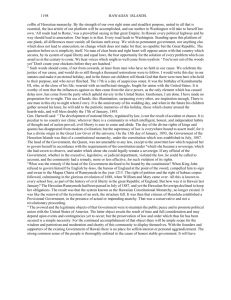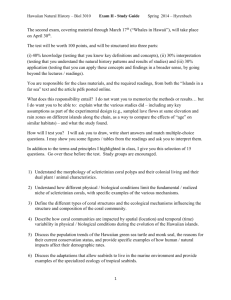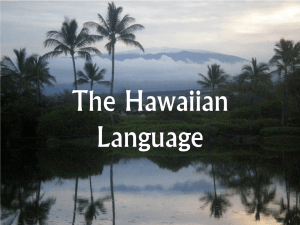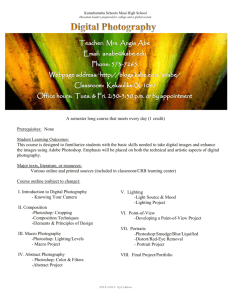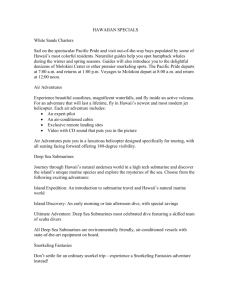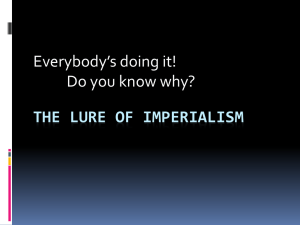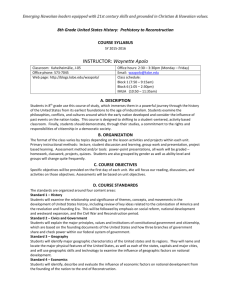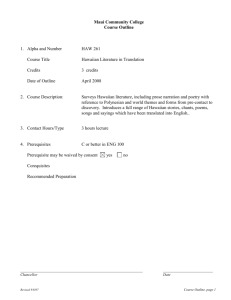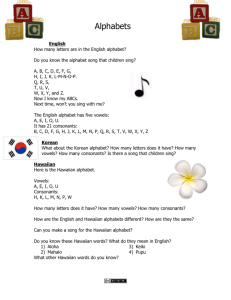References
advertisement
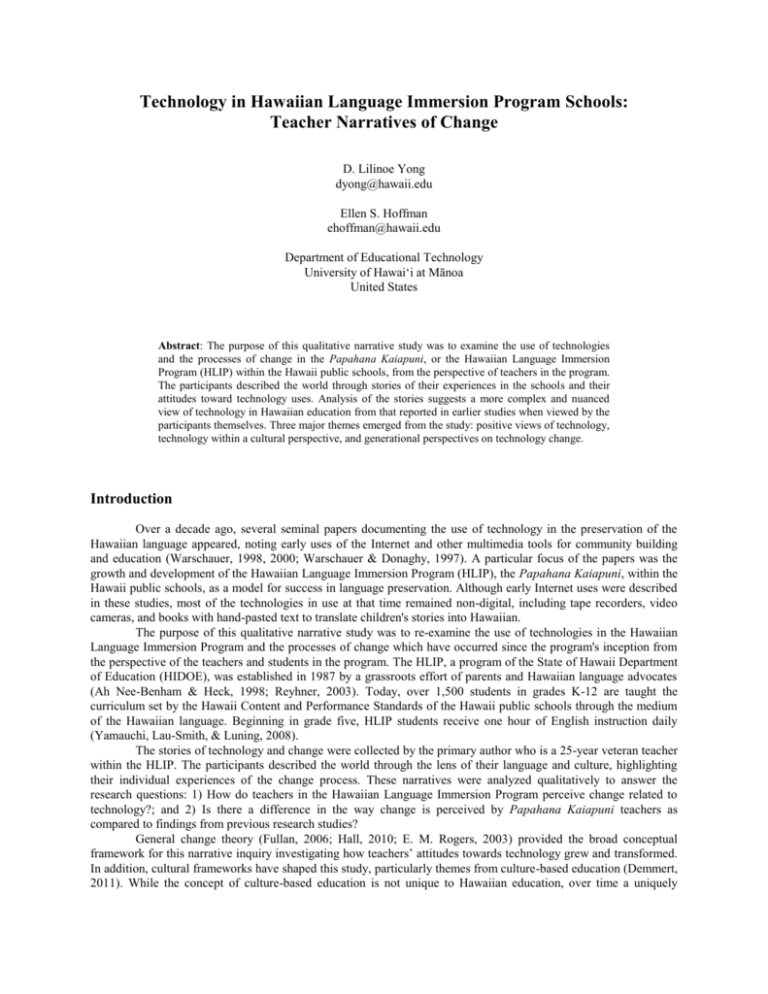
Technology in Hawaiian Language Immersion Program Schools: Teacher Narratives of Change D. Lilinoe Yong dyong@hawaii.edu Ellen S. Hoffman ehoffman@hawaii.edu Department of Educational Technology University of Hawai‘i at Mānoa United States Abstract: The purpose of this qualitative narrative study was to examine the use of technologies and the processes of change in the Papahana Kaiapuni, or the Hawaiian Language Immersion Program (HLIP) within the Hawaii public schools, from the perspective of teachers in the program. The participants described the world through stories of their experiences in the schools and their attitudes toward technology uses. Analysis of the stories suggests a more complex and nuanced view of technology in Hawaiian education from that reported in earlier studies when viewed by the participants themselves. Three major themes emerged from the study: positive views of technology, technology within a cultural perspective, and generational perspectives on technology change. Introduction Over a decade ago, several seminal papers documenting the use of technology in the preservation of the Hawaiian language appeared, noting early uses of the Internet and other multimedia tools for community building and education (Warschauer, 1998, 2000; Warschauer & Donaghy, 1997). A particular focus of the papers was the growth and development of the Hawaiian Language Immersion Program (HLIP), the Papahana Kaiapuni, within the Hawaii public schools, as a model for success in language preservation. Although early Internet uses were described in these studies, most of the technologies in use at that time remained non-digital, including tape recorders, video cameras, and books with hand-pasted text to translate children's stories into Hawaiian. The purpose of this qualitative narrative study was to re-examine the use of technologies in the Hawaiian Language Immersion Program and the processes of change which have occurred since the program's inception from the perspective of the teachers and students in the program. The HLIP, a program of the State of Hawaii Department of Education (HIDOE), was established in 1987 by a grassroots effort of parents and Hawaiian language advocates (Ah Nee-Benham & Heck, 1998; Reyhner, 2003). Today, over 1,500 students in grades K-12 are taught the curriculum set by the Hawaii Content and Performance Standards of the Hawaii public schools through the medium of the Hawaiian language. Beginning in grade five, HLIP students receive one hour of English instruction daily (Yamauchi, Lau-Smith, & Luning, 2008). The stories of technology and change were collected by the primary author who is a 25-year veteran teacher within the HLIP. The participants described the world through the lens of their language and culture, highlighting their individual experiences of the change process. These narratives were analyzed qualitatively to answer the research questions: 1) How do teachers in the Hawaiian Language Immersion Program perceive change related to technology?; and 2) Is there a difference in the way change is perceived by Papahana Kaiapuni teachers as compared to findings from previous research studies? General change theory (Fullan, 2006; Hall, 2010; E. M. Rogers, 2003) provided the broad conceptual framework for this narrative inquiry investigating how teachers’ attitudes towards technology grew and transformed. In addition, cultural frameworks have shaped this study, particularly themes from culture-based education (Demmert, 2011). While the concept of culture-based education is not unique to Hawaiian education, over time a uniquely Hawaiian version has emerged (Kanaʻiaupuni & Kawaiʻae’a, 2008; Kanaʻiaupuni, Ledward, & Jensen, 2010). As will be shown in the results below, this cultural perspective provided a strong underlying pattern in the way the teachers' stories were told and the way in which they situated their technology views. The Study With a strong tradition of storytelling in Hawaiian culture and among the participants in the study, the use of a qualitative narrative inquiry method was applied as a way to understand the stories told while preserving cultural coherence and individual sense making. Narrative inquiry offers a way for teachers to self-report (Blank, 2002), selflearn and self-criticize (Denzin, 2008), and to critique their practices through the lens of experiential stories (C. Rogers, 2010). The participants in the study were eight teachers from the HLIP, four who were teachers in the early history of the schools and four who were initially students who have now become teachers; some of the pioneer teachers are now employed in educational settings outside HLIP classrooms. The teachers taught at HLIP schools on the Hawaiian islands of Oahu, Maui, and Hawaii. Hawaii Department of Education and University of Hawaii institutional review board permission and teacher consent were secured before data collection began. Data were collected through narrative inquiry, or the telling of one’s story based on real-life experience (Clandinin & Connelly, 2000; Clandinin, Pushor, & Orr, 2007). The narratives were collected during semi-structured interviews conducted in Hawaiian in each individual participant's school or work setting after school hours by the primary researcher. The data collection period began in the fall of 2011 and ended before spring of 2012. Two research assistants fluent in Hawaiian aided the primary author in the interviews, transcription, and translation. The recorded interviews were transcribed and translated into English. Each interviewee was sent the transcription and translation of her/his session to review the written texts for accuracy. Each story was analyzed in terms of major thematic elements (Webster & Mertova, 2007). Thematic coding was completed by the primary researcher, reviewed by the research assistants, then each participant was given the opportunity to review the themes to validate their concerns about implementation of technology in the classroom. The themes were compared among the narratives and reviewed by the secondary author, an outsider and experienced qualitative researcher. Potential limitations of the study include the small sample size, in this case eight teachers out of a total of 85, the role of the primary author and interviewer as an insider, and possible inhibitions by the participants to speak with candor on the topics of the study. Standard approaches to improving trustworthiness or validity (Creswell & Miller, 2000) included purposeful sampling to include a range of participants, member checking at both the translation stage and thematic analysis stage, the use of two research assistants who attended HLIP schools who assisted with story collection and added additional expertise in translation, and peer review of coding and themes. Findings The final product of the research consists of the stories or narratives as told by each teacher and a thematic analysis. In the original study report, each narrative was written separately in the original Hawaiian and translated into English. However, the narratives are too long to be included in this short paper but are being published elsewhere. The results in this section focus on describing three of the major themes that emerged through the analysis which are illustrative of worldview and change. All results below are reported in English only. Positive Views of Technology All eight of the teachers in the study indicated a positive attitude toward the use of technology within the HLIP. In fact, their stories in general echo a pride in the accomplishments of the HLIP in the Hawaiian cultural renaissance and a recognition of the positive role of technology in that success. Those who were initially students and have become teachers in HLIP recalled the past technologies that were used. When I went to Hawaiian Language Immersion I didn’t use the Leokī email. There were not enough computers…..Video recording machines were used by me when I went to Hawaiian Language Immersion Schools, using the tools that we had at that time. I saw pictures, video, cassette tapes of us singing, roleplaying, and speaking. Despite the changing of technology and increased access and availability, the teachers noted that computer applications continue to lack adequate support for the Hawaiian language. This challenge remains an issue, and one which requires extra effort by the teachers. My class has a smartboard. That’s technology….This smartboard shows videos, it can make sounds, and it’s like the iPod Touch because the children make choices, draw and enlarge it with their fingers, and move things like that. The interest in technology is growing, but there are not enough tools in Hawaiian. In this telling, all the teachers paralleled the earlier studies of Hawaii as a model for technology as a key to language preservation and expansion. Typical comments included: Technology has helped this program to progress, because that is how we make the Hawaiian Language known to others, and that is how we teach our kids. At the same time, the teachers also recognized the increasing impact of technology in US society generally and therefore saw it as important in classroom teaching. Not only are teachers using technology regularly but students expect to have it in the schools and are more ready to use it throughout the curriculum, according to the teachers' reports. While technology played a key role earlier in the program's history, uses continue to expand. For a number of years we didn’t reach the level of readiness. Students didn’t enter ready for technology. They were at a beginner level and we had to teach them….Now, we can fully utilize technology in the math class, in technology class. Therefore, technology has become more of a tool. Everyone has email, computer, cell phone and such; therefore, as those needs grow, [they] grow with the Hawaiian language. Like the Mac[intosh] these days, they have glottal stop and the macron [keyboard symbols required to write the Hawaiian language correctly], therefore, it is easy to type and print – we don’t need to write. The fifth graders took pictures and made iMovies. They made them themselves. This is interesting for them. They can show it to their parents. It is a keepsake. Technology in a Cultural Setting While the teachers spoke of using such common classroom applications as smartboards, digital video, email, document creation, and Internet information searching, each teacher described these within a cultural context that extended learning to include enhancing cultural values and spiritual understanding. This contrasts with the focus on standards and academic achievement that is often the underpinning for technology discussions more generally in U.S. schools. My purpose for telling this story is to revive the language. It is a reason to compare to a model school. This is different from American models. [Ours] is culture-based education. Further, by framing technology use within a cultural worldview, the teachers stories deviate from the reports of earlier, more technical descriptions of researchers such as Warschauer (1998) who were outsiders. However, even at that time, he indicated the cultural basis of applications of the Internet and multimedia in HLIP schools. "What I do want to point out, though, is that Hawaiian educators have attempted to make use of the Internet in ways that they feel build from the best learning traditions of their students" (p. 150). The values and purposes of Hawaiian culture based education as described by Kana‘iaupuni & Kawai‘ae‘a (2008) provide a basis for the language and rhythm of these stories that places technology within a Hawaiian social context. Culture based education has been described as "teaching and learning that are grounded in a cultural worldview, from whose lens are taught the skills, knowledge, content, and values that students need in our modern, global society" (p. 71). Within this framework, technology is only one tool among many, and is applied in ways carefully considered in relation to cultural values to reach desired goals. For example: I have but one small concern. In the Hawaiian Immersion Schools you have to reflect on the Hawaiian ways, Hawaiian ways not just technology. Generations in Change While all teachers indicated a positive view of technology and used a cultural framework in describing their teaching with technology, some differences were found in how each teacher saw the continuing role of technology reflecting generational differences in the stories. This contrast is not explicitly recognized by these teachers as a difference but emerged from the comparative thematic analysis. This relates to how each talks about technology use in their classes and by other teachers. For the pioneer teachers, technology is described predominantly as a tool for language preservation and teacher based curriculum tools. For example, one teacher noted that the point of her storytelling was specific to the issues of language preservation. I am telling my story as you requested, to tell you my opinion and answer these questions to help strengthen the Hawaiian speaking schools and to revive the language and the culture in Hawaii. By contrast, the four newer teachers acknowledge their debt to the teachers who came before and the issues of preserving elder voices, but for them technology is more a part of everyday life and multiple uses. The stories by the newer teachers provide more examples of direct use by students in classes and of technology as a jointly used curricular tool. Only the newer teachers spoke of the role technology in motivating students, and two of them stated that failure to use technology in classrooms would be viewed poorly by the students who are using technology all the time outside of school. In the beginning of technology, it was just an extension of text in word documents. I see the progress in my daughter in twelfth grade now with investigations on the computer, searching and utilizing it until she posts the product of her technology skills. My daughter photographs and video records events for documentation and those tools are helpful. I think these skills are needed when [these current students] enter college, and also when they acquire a job. But just as there are suggestions of differences among the two generations of teachers based on the stories recorded, there is also another generational difference perceived by all of the teachers. This is the contrast between students today, who grew up with ubiquitous technology and use it intensively in their personal lives, from the teachers who have different histories with technology and most often speak of it from a professional viewpoint. While none of the teachers even hinted at technology not continuing as an important part of the learning environment in the HLIP schools, each expressed in different words a cautionary tale. This suggests that the commonly accepted view of Hawaiian culture as having embraced technology as a central element of regeneration is more nuanced and perhaps shifting from that reported by earlier researchers. The technologies are different, but the results are the same. The truth of the matter is I don’t see any harm in technology. The problem lies within the behavior of the person. One needs to think, what is the proper usage of the technology for us. Conclusions This collective story of change reflects on a new generation of indigenous language speakers (Kawai‘ae‘a, Housman, & Alencastre, 2007). The stories told are unique to the Hawaiian peoples and histories, and reflect a viewpoint that, while parallel to other indigenous groups working on language preservation, also show some important differences from other studies as well as from earlier reports on the HLIP. This study supported previous research relating to increased use of technology by teachers as both consumers and producers of information. While there is much support by the teachers for the use of technology in the classroom, there is also a concern about the balance of technology (‘enehana) and traditional Hawaiian knowledge (‘ike ku‘una). If there is one primary point of significance that emerges from this study, it is that when participants are given a chance to voice their stories in their own words and with researchers who bring a sympathetic and insider perspective, a far more complex and complete story emerges of change and cultural values than from those often implied by the neatly delineated models in social science research. Native peoples must have a voice, we must ask the questions and critique existing knowledge. We must not only be evaluated, we must evaluate. We must not be researched, but research. By cementing our presence in the production of knowledge, we can be vigilant over how it is used and the power that knowledge confers. (Kanaʻiaupuni, 2004) Storytelling is a “way of knowing” based on experience, and it allows the “silenced voices” to be heard (Denzin, Lincoln, & Giardina, 2006, p. 774). After all, “you don’t have anything if you don’t have the stories” (Ah Nee-Benham & Cooper, 2000, p. 4) References Ah Nee-Benham, M. K. P., & Cooper, J. E. (2000). Indigenous educational models for contemporary practice: In our mother's voice. Mahwah, NJ: L. Erlbaum Associates. Ah Nee-Benham, M. K. P., & Heck, R. H. (1998). Culture and educational policy in Hawai`i: The silencing of native voices. Mahwah, NJ: L. Erlbaum Associates. Blank, R. K. (2002). Using surveys of enacted curriculum to advance evaluation of instruction in relation to standards. Peabody Journal of Education, 77(4), 86-121. doi: 10.1207/s15327930pje7704_5 Clandinin, D. J., & Connelly, F. M. (2000). Narrative inquiry: Experience and story in qualitative research. San Francisco, CA: Jossey-Bass. Clandinin, D. J., Pushor, D., & Orr, A. M. (2007). Navigating sites for narrative inquiry. Journal of Teacher Education, 58(1), 21-35. doi: 10.1177/0022487106296218 Creswell, J. W., & Miller, D. L. (2000). Determining validity in qualitative inquiry. Theory Into Practice, 39(3), 124-130. doi: 10.1207/s15430421tip3903_2 Demmert, W. G., Jr. (2011). What is Culture-Based Education? Understanding pedagogy and curriculum. In J. Reyhner, W. S. Gilbert & L. Lockard (Eds.), Honoring our heritage: Culturally appropriate approaches to indigenous education (pp. 1-9). Flagstaff, AZ: Northern Arizona University. Denzin, N. K. (2008). The new paradigm dialogs and qualitative inquiry. International Journal of Qualitative Studies in Education, 21(4), 315-325. doi: 10.1080/09518390802136995 Denzin, N. K., Lincoln, Y. S., & Giardina, M. D. (2006). Disciplining qualitative research. International Journal of Qualitative Studies in Education, 19(6), 769-782. doi: 10.1080/09518390600975990 Fullan, M. (2006). Change theory: A force for school improvement. Center for Strategic Education Seminar Series Paper No. 157. Victoria, Australia: CSE. Retrieved from http://www.michaelfullan.ca/Articles_06/06_change_theory.pdf Hall, G. E. (2010). Technology’s Achilles heel: Achieving high-quality implementation. Journal of Research on Technology in Education, 42(3), 231-253. Kanaʻiaupuni, S. M. (2004). Kaʻakālai kū kanaka: A call for strengths-based approaches from a Native Hawaiian perspective. Educational Researcher, 33(9), 26-32. Kanaʻiaupuni, S. M., & Kawaiʻae’a, K. K. C. (2008). E lauhoe main ā waʻa: Toward a Hawaiian indigenous education teaching framework. Hūlili: Multidisciplinary Research on Hawaiian Well-Being, 5, 67-90. Kanaʻiaupuni, S. M., Ledward, B., & Jensen, U. (2010). Culture-based education and its relationship to student outcomes. Honolulu, HI: Kamehameha Schools Research & Evaluation Division. Retrieved from http://www.ksbe.edu/spi/PDFS/CBE_relationship_to_student_outcomes.pdf Kawai‘ae‘a, K. K. C., Housman, A. K., & Alencastre, M. K. (2007). Pūʻā i ka ʻōlelo, ola ka ʻohana: A living case study of three Hawaiian language families over one generation of revitalizing the Hawaiian language. Hülili: Multidisciplinary Research on Hawaiian Well-Being, 4(1), 183-237. Retrieved from http://www.ksbe.edu/SPI/Hulili/vol_4.php Reyhner, J. (2003). Native language immersion. In J. Reyhner, O. Trujillo, R. L. Carrasco & L. Lockard (Eds.), Nurturing native languages (pp. 1-6). Flagstaff, AZ: Northern Arizona University. Retrieved from http://jan.ucc.nau.edu/~jar/NNL/ Rogers, C. (2010). It takes a village: Decolonization, experiential narrative, and community-centered learning in a reservation bordertown. University of Wyoming. Available from ProQuest Dissertations and Theses database. Rogers, E. M. (2003). Diffusion of innovations (5th ed.). New York, NY: Free Press. Warschauer, M. (1998). Technology and indigenous language revitalization: Analyzing the experience of Hawai'i. Canadian Modern Language Review/ La Revue canadienne des langues vivantes, 55(1), 139-159. doi: 10.3138/cmlr.55.1.139 Warschauer, M. (2000). Language, identity and the Internet. In B. Kolko, L. Nakamura & G. Rodman (Eds.), Race in cyberspace (pp. 151-170). New York, NY: Routledge. Warschauer, M., & Donaghy, K. (1997). Leoki: A powerful voice of Hawaiian language revitalization. Computer Assisted Language Learning, 10(4), 349-361. doi: 10.1080/0958822970100405 Webster, L., & Mertova, P. (2007). Using narrative inquiry as a research method: An introduction to using critical event narrative analysis in research on learning and teaching. New York, NY: Routledge. Yamauchi, L. A., Lau-Smith, J.-A., & Luning, R. J. I. (2008). Family involvement in a Hawaiian language immersion program. The School Community Journal, 18(1), 39-60.
